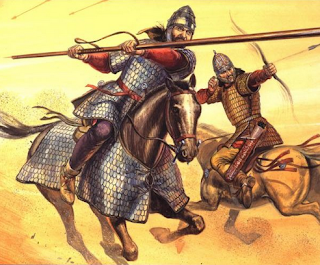Sarmatian Cavalry
In the early Arthurian poem the PA GUR, the hero Mabon (= the god Apollo Maponus) is called one of the 'vulture [GPC, 'predatory birds'] of Elei.' Elei (or Elai) is the ancient name for the Ely River in southern Wales. A reference to the Ely is puzzling, as every other place-name mentioned in the poem is in northern Britain. And, indeed, excepting the Elei, the place-names do not take us further south than Derbyshire.
Patrick Sims-Williams, in Note 28, p. 63, to his "The Early Welsh Arthurian Poems" (in THE ARTHUR OF THE WELSH), says this about the word vytheint:
"Vytheint 'vultures' (line 11) is an emendation of the meaningless vythneint '?eight streams'. a scribal error perhaps influenced by awareness that Elei was the name of a stream, or by confusion with the word gwyth, pl. gwytheint, 'stream'."
Before I discuss his note, it is important to point out that a Mabon is metaphorically compared to a bird in a Taliesin poem. From Bartram's A CLASSICAL WELSH DICTIONARY:
"Another poem in the Book of Taliesin, Kychwedyl am dodyw (BT 38-39), but probably not Taliesin's genuine work, describes the battles of Owain ab Urien. It mentions Mabon four times and 'mab Idno' occurs in the same poem. We learn that Mabon was a fierce warrior, but it is not clear whether he was for or against Owain:
'Unless they were to fly with wings they could not escape from Mabon without slaughter.'
(BT 39.3). See John Morris-Jones in Cy. 28 (1918) pp.198-9; TYP p.434. The mention of 'mab Idno' suggests that we have here Mabon ab Idno of the ‘Hanesyn Hen’ tract."
What I think we may have in Line 11 of the PA GUR poem is a garbled reference to Latin alae:
al.ae N 1 1 GEN S F
al.ae N 1 1 LOC S F
al.ae N 1 1 DAT S F
al.ae N 1 1 NOM P F
al.ae N 1 1 VOC P F
ala, alae N F [XXXAO]
wing; upper arm/foreleg/fin; armpit; squadron (cavalry), flank, army's wing
What I'm suggesting is that at some point elai/elei was wrongly substituted for alae. As soon as that was done, vytheint, here symbolic of the predatory birds of the cavalry wing or wings, was associated with a word for streams. Please understand I am not trying here to establish a linguistic relationship of any kind between elei/elai and alae. Rather, I'm proposing a couple of simple errors which led to a line that does not fit the context of the poem.
Mabon was, instead, a 'vulture of the [cavalry] wing', indicating that he was a horse warrior who rode so quickly none could escape him.
This may not be as outlandish idea at it first may seem. Elei was in at least one case in the PA GUR identified with another place in Britain. So there is ample room for confusion in this line. From an earlier piece on this subject:
A complicating factor is the presence of Gwyn Godyfrion amongst the wythaint/birds of prey of Elei. Once we drop the intrusive prefix Go- ("under"), we have the place-name Waendofron (965-971), modern Wendover in Buckinghamshire. According to Ekwall, this is a British name for the clear chalk stream at the place, corresponding to Welsh gwyn, 'white', and dwfr, 'river.' Wendover is near to Aylesbury, and it is likely Ayles- (from AS Aegeles/Aegles/Eiles-) has been fancifully linked to Elei. The problem is that there is absolutely no justification for placing Mabon servant of Uther Pendragon at Wendover or in the Vale of Aylesbury. Dyfrion/dybrion, 'water(s)', is attested in Welsh according to Dr. Simon Rodway of The University of Wales. Patrick Sims-Williams (in his "The Early Welsh Arthurin Poems", THE ARTHUR OF THE WELSH, p. 40) says "The epithet , which is perhaps a place-name, looks as if it contains OW dubr 'water' (cf. Old Irish fodoborda(e) 'underwater, aquatic'?)."
This may not be as outlandish idea at it first may seem. Elei was in at least one case in the PA GUR identified with another place in Britain. So there is ample room for confusion in this line. From an earlier piece on this subject:
A complicating factor is the presence of Gwyn Godyfrion amongst the wythaint/birds of prey of Elei. Once we drop the intrusive prefix Go- ("under"), we have the place-name Waendofron (965-971), modern Wendover in Buckinghamshire. According to Ekwall, this is a British name for the clear chalk stream at the place, corresponding to Welsh gwyn, 'white', and dwfr, 'river.' Wendover is near to Aylesbury, and it is likely Ayles- (from AS Aegeles/Aegles/Eiles-) has been fancifully linked to Elei. The problem is that there is absolutely no justification for placing Mabon servant of Uther Pendragon at Wendover or in the Vale of Aylesbury. Dyfrion/dybrion, 'water(s)', is attested in Welsh according to Dr. Simon Rodway of The University of Wales. Patrick Sims-Williams (in his "The Early Welsh Arthurin Poems", THE ARTHUR OF THE WELSH, p. 40) says "The epithet , which is perhaps a place-name, looks as if it contains OW dubr 'water' (cf. Old Irish fodoborda(e) 'underwater, aquatic'?)."
Maponus was worshipped at the Ribchester Roman fort, which I have identified as the home of Arthur's father Sawyl Benisel (= Uther Pendragon). And we have some evidence of an ala of Sarmatians based there:
https://romaninscriptionsofbritain.org/org/1912
http://roman-britain.co.uk/military/alaisar.htm
https://books.google.com/books?id=3gz8CgAAQBAJ&pg=PA402&lpg=PA402&dq=%22Ala+sarmatarum%22&source=bl&ots=GiOrA1Gl1Q&sig=ACfU3U1smyp6hMAC6nkfQwPjLff_wN4Elw&hl=en&sa=X&ved=2ahUKEwirjeazypPhAhUJh1QKHdnlAYMQ6AEwBHoECAUQAQ#v=onepage&q=%22Ala%20sarmatarum%22&f=false
https://www.jstor.org/stable/526988?seq=1#page_scan_tab_contents
https://books.google.com/books?id=WZ7HAAAAQBAJ&pg=PA421&lpg=PA421&dq=%22Ala+Sarmatarum%22&source=bl&ots=DUY3FQmIXD&sig=ACfU3U2zUibRcJBJFEPu2xEpkxlNKKfEJQ&hl=en&sa=X&ved=2ahUKEwi54uXsy5PhAhWQ_1QKHUYHDMIQ6AEwCHoECAYQAQ#v=onepage&q=%22Ala%20Sarmatarum%22&f=false
https://romaninscriptionsofbritain.org/org/1912
http://roman-britain.co.uk/military/alaisar.htm
https://books.google.com/books?id=3gz8CgAAQBAJ&pg=PA402&lpg=PA402&dq=%22Ala+sarmatarum%22&source=bl&ots=GiOrA1Gl1Q&sig=ACfU3U1smyp6hMAC6nkfQwPjLff_wN4Elw&hl=en&sa=X&ved=2ahUKEwirjeazypPhAhUJh1QKHdnlAYMQ6AEwBHoECAUQAQ#v=onepage&q=%22Ala%20sarmatarum%22&f=false
https://www.jstor.org/stable/526988?seq=1#page_scan_tab_contents
https://books.google.com/books?id=WZ7HAAAAQBAJ&pg=PA421&lpg=PA421&dq=%22Ala+Sarmatarum%22&source=bl&ots=DUY3FQmIXD&sig=ACfU3U2zUibRcJBJFEPu2xEpkxlNKKfEJQ&hl=en&sa=X&ved=2ahUKEwi54uXsy5PhAhWQ_1QKHUYHDMIQ6AEwCHoECAYQAQ#v=onepage&q=%22Ala%20Sarmatarum%22&f=false

No comments:
Post a Comment
Note: Only a member of this blog may post a comment.